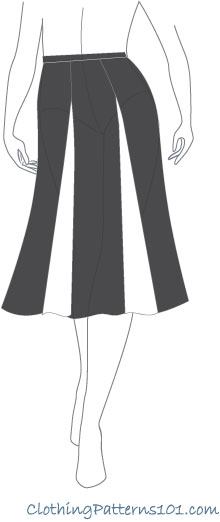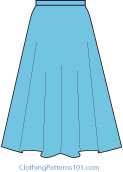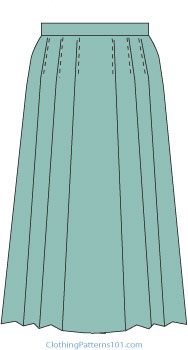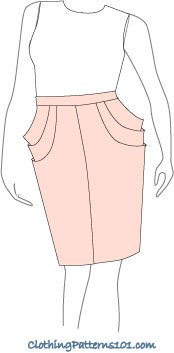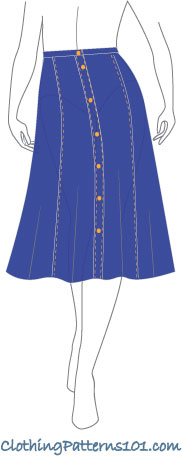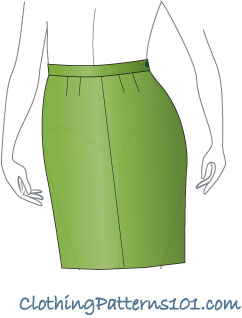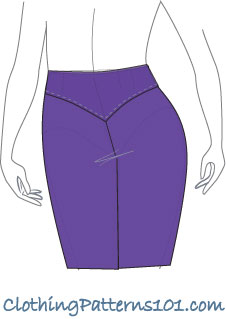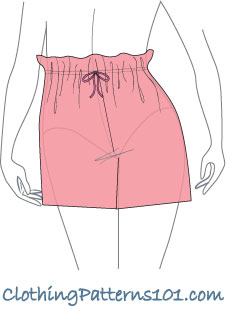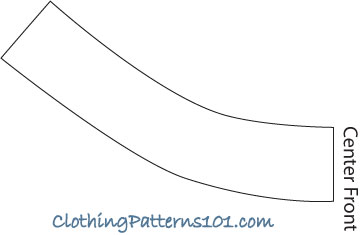- Clothing Patterns 101
- Skirt Patterns
- Trumpet and Godet Skirts
Add Flare to Your Gored Skirt with a Trumpet or Godet!
A trumpet or godet skirt is simply a gored skirt, with additional flare at the hem.
While both variations add flare, how and where that flare is added is what differentiates the two techniques.
Both variations offer a lot of styling options, so they are great techniques to add to your pattern collection!.
Drafting the Trumpet Flare Skirt
|
The example, above, starts with a 6-gore skirt pattern. Since that has already been addressed here, I won't repeat those steps. Once you have your 6-gore skirt pattern, simply add flare to the hem! In this example, I am adding 4" of width at the hem, on each side of the pattern pieces. The flare starts at about the lower thigh. The starting point is up to you - starting at a higher point will soften the angular shape of the side seam, although the fullness at the hem will be the same. I have added the extra width on only one side of the center front pattern piece, because it is cut on the fold. Adding 4" to each side of each of the 6 gores (panels) of the skirt adds a total of 48" to the hem of the skirt! That is a LOT of flare! |
For a slightly more dramatic look, you can "scoop in" the side seam just a bit, from the bottom of the hip to the point where the skirt starts to flare out (shown at the left side of the sketch, above). This helps the skirt "hug" your legs below the hip and derriere, emphasizing the trumpet shape of the skirt.
For less drama, add only 2" per side - for a total of 24" added to the hem. This still adds quite a bit of fullness, without the extreme trumpet shape.
|
The final pattern will look much like the one at left. I am showing only the front pattern pieces: I have "opened" the center front panel to show the full panel with flare at both sides, rather than the "on the fold" version. Of course, you would cut one of the center front, and two of the side panels. The back skirt is drafted in the same manner and the pieces would look much the same. Remember to add notches to guide you as you stitch your seams! |
In a soft, fluid fabric, the fullness at the hem will move and sway as you walk. In a slightly firmer fabric, with the addition of nylon horsehair braid in the hem, the flare will become a more stable, firm, undulating shape.
Both are attractive; it just depends on what look you're going for!
Drafting the Godet Skirt
|
A Godet Skirt, like the trumpet skirt, is a segmented skirt (gored) with added flare. But instead of adding flare to each panel, the godet skirt ADDS A TRIANGULAR SHAPED PANEL between the gores for flare. These triangles are called godets. Start with a 6-gore skirt. Then, draft the godet: In this case, the length of the godet is the same as the length of the skirt from the point of the dart to the hem. To add an amount similar to the trumpet skirt, each godet can be 8" wide at the hem (that replicates the 4" on each side of the gores on the trumpet skirt). Then just draft a triangle! From the 8" line at the hem (4" + 4"), draw a line perpendicular and upward, equal to the length of the skirt from the dart to hem. It's as simple as that! |
The final pattern will look like the one at left: The center front piece (still shown as a "cut on fold"), plus the side front panel (cut 2 of those) and the godet piece (cut 2 of those, also). The back will be drafted and look very much the same as the front. Add notches to guide you as you stitch the skirt together. One of the nice things about the godet skirt as opposed to the trumpet flare is that the godets allow an opportunity to introduce contrast into the skirt design. You can use a contrasting color (we've sketched it in black with white godets) or a fabric of a different texture. For cocktail or formal wear, the skirt could be satin, for example, with gores made of lace. |
Both of these skirt techniques can produce shapes that are very similar and allow for many options.
While I've shown the trumpet skirt flaring from the lower thigh, you could easily start the flare at the low hip and achieve a shape very similar to that of the black/white godet skirt. The flare is more subtle and less "trumpet", but it's still a lovely shape, without the addition of extra pieces (the godets).
On the other hand, you could make your godets much shorter - the length of the skirt from the lower thigh to the hem, for example (similar to the flare added to the trumpet skirt). In this case, the shape of the godet skirt would resemble that of the green trumpet skirt - but with the option of contrast in the godets.
Any or all of these options are perfectly fine. Play with these ideas for adding flare and fullness to your skirt. There's so much you can do aside from a full or circle skirt!
More Skirts
More Waist Treatments
Return to Clothing Patterns 101 Home Page
ClothingPatterns101.com does not sell the personal information of its users to anyone, ever.

